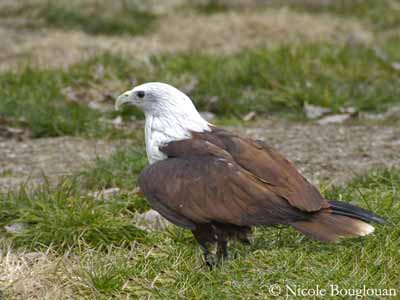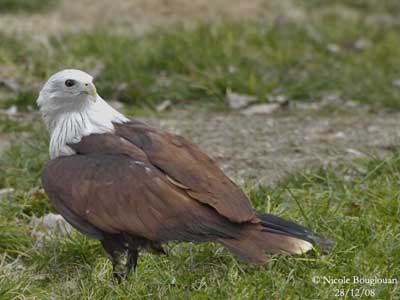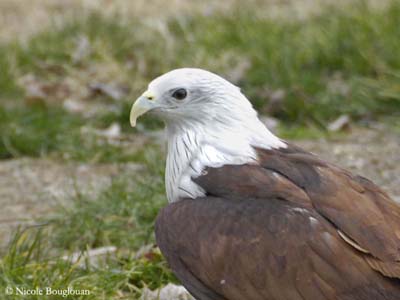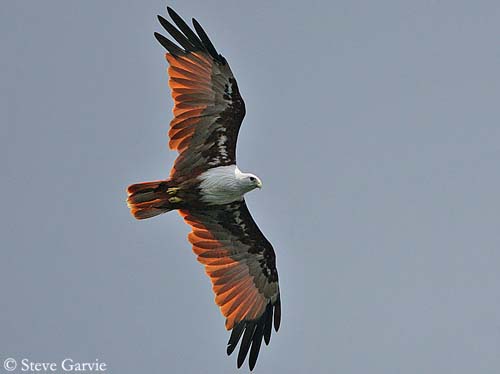
Brahminy Kite
Haliastur indus
Accipitriforme Order – Accipitridae Family
BIOMETRICS :
Length : 45 à 51 cm
Wingspan : 109 à 124 cm
Weight : 320 à 670 g
DESCRIPTION:
Brahminy Kite has bright chestnut plumage except on head, neck and breast which are white, slightly streaked greyish-white. The broad wings are chestnut with blackish tips. The tail is rather short, tipped buffy-white. In flight, it appears rounded.
On the underparts, chin, throat, breast and upper belly are white, with fine pale grey streaks. Lower belly, vent and undertail coverts are chestnut. Undertail feathers are chestnut, edged buffy-white. On the underwing, coverts are chestnut whereas flights feathers are buff-white. Wings are tipped black on primaries.
The slender, very hooked bill is pale yellow to horn-coloured. Eyes are dark brown. Legs and talons are pale yellow.
Female is similar to male, but she is larger and heavier.
Juvenile resembles adults, but it has browner plumage with whitish edges. The white parts are rather buffy-white streaked brown. The bill is blackish. On the underparts, secondary flight feathers and undertail feathers are greyish-brown. Primary flight feathers are whitish.
PROTECTION / THREATS / STATUS:
Brahminy Kite is abundant and widespread in tropical parts of the range, benefiting from human activities.
In Australia, the DDT use and the disturbances threaten the species. In some parts of the range, such as in Java and Thailand, the species suffered decline due to pesticides, hunting and collection of nestlings at nest for sale, and loss of breeding habitat.
However, the populations are not globally threatened at this moment.
Fr: Milan sacré
All: Brahminenweih
Esp: Milano Brahmán
Ital: Nibbio di Brahama
Nd: Brahmaanse Wouw
Russe: Браминский коршун
Sd: Braminglada
Photograph of the flying bird by Steve Garvie
His website: RAINBIRDER Photo galleries
Photographs and text by Nicole Bouglouan
Photographs taken at the Zoo Aquarium of Madrid - Spain
Sources:
HANDBOOK OF THE BIRDS OF THE WORLD Vol 2 by Josep del Hoyo-Andrew Elliot-Jordi Sargatal - Lynx Edicions - ISBN: 8487334156
TROPICAL BIRDS OF SOUTHEAST ASIA by Morten Strange - Tuttle Publishing - ISBN: 9625931678
Birds in backyards (Birds Australia and Australian Museum)
The Hawk Conservancy Trust (Hilary Smith)
Sungei Buloh Wetlands Reserve (Michael Mastaller)
Wikipedia (Wikipedia, The Free Encyclopedia)

Brahminy Kite has four subspecies:
H.i. Indus; H.i. intermedius; H.i. girrenera; H.i. flavirostris.
They differ by some regional variation in plumage and bill colour. If Australasian races have pure white head and breast, the birds living in Salomon islands have yellow bill.
VOICE: SOUNDS BY XENO-CANTO
Brahminy Kite utters mewing calls “keeyew” usually while soaring. However, it is usually silent. In addition to mewing notes, it gives some bleating “pee-ah-ah-ah”.
HABITAT:
Brahminy Kite lives mainly in coastal regions, estuaries, mangroves, wetlands, and even in urban areas.
RANGE:
Brahminy Kite lives in India, Pakistan, Bangladesh and Southeast Asia, and also in New South Wales in Australia where it is widespread and resident on coastal regions and along rivers.
In mainland Asia, this species breeds at about 2400 metres of elevation, and it occurs at 2300 metres in New Guinea.
BEHAVIOUR:
Brahminy Kite feeds on wide variety of food items and carrion. It feeds on mammals, birds, reptiles, amphibians, fish, arthropods, crustaceans, road-kill vertebrates, larges carcasses and offal. It may kill domestic poultry.
It soars high in the air, watching for preys. It also hunts from exposed perch, and may also search on the ground. When a prey is detected, it seizes it by glide or dive, performing short chase. It hawks flying insects, snatches preys from canopy and water surface. It may perform piracy from fishing birds such as gulls and ospreys.

Brahminy Kite has keen view and can see its prey from a distance. It is able to lift live fish from the water, but most of time, it scavenges on beaches or takes debris from the water surface seizing them with its talons.
Brahminy Kite frequents the harbours and fish-farms where it feeds close to humans. Outside the feeding periods, it rests on branches often near water. It forages as over water or over land, and soars at about 20 to 50 metres above the surface or the ground.
It flushes shorebirds on mudflats into flight and pursues the weakest. It is attracted by fires in order to catch the escaped animals.
Brahminy Kite is mostly resident in Asia and Australia, and performs only local movements for food.
FLIGHT:
Brahminy Kite has long, broad, rounded wings. It performs slow, deep flapping wing beats. During the breeding season, it performs acrobatic flight displays.

Female lays 1 or 2 white eggs with some reddish-brown markings. Incubation lasts about 28 to 35 days, by female.
Chicks are covered with cream to rufous down. They fledge about 44 to 56 days after hatching, according to the region. They reach their sexual maturity at 2 years of age.
Both parents share the nesting duties. Breeding pairs are sedentary.
DIET:
Brahminy Kite feeds on wide variety of small preys and carrion. It hunts for mammals, birds, reptiles, aquatic animals taken with the talons, crustaceans, amphibians, fish… It hawks flying insects and performs piracy from fishing birds.
They gather around large carcasses where they squeal.

